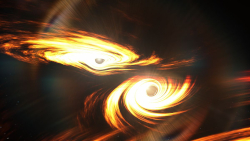 HEAPOW: How Eccentric are Black Hole Pairs? (2022 Sep 19)
HEAPOW: How Eccentric are Black Hole Pairs? (2022 Sep 19)
Ever since the first collision and merger of a pair of black holes was detected by LIGO back in 2015, scientists have been wondering about the types of black hole binaries there are in outer space. How long are their periods? How extreme can the masses of the two stars be? And how do these binary black holes form, anyway? Scientists think that most black holes found in galaxies form at the end of a star's life, if the star is about 20 times the Sun's mass, or more. When a such a massive star eventually runs out of thermonuclear fuel, the core of the star collapses, creating a supernova outburst. If the dead core is more massive than about 5 solar masses, nothing can stop the crush of gravity and the core will collapse to a "singularity", a point of infinite density, forming a black hole. But the resulting black holes should have masses less than 30 Suns (or even less). The surprising thing is that the derived masses of many of the black holes seen by gravitational wave observatories are well above this limit. A simple explanation is that these "overweight" black holes have grown so large by eating other massive objects, like unfortunate nearby stars or other black holes. For an isolated pair of black holes (like those two in the artist illustration above, with swirling stuff around them), the instantaneous orbit of the two around their common center of mass should become more and more circular as the stars spiral together. Recently, scientists have tested one merger, the gravitational wave event GW190521, to see how eccentric its orbit was just before it merged. The black holes which merged during this event were especially massive, with masses of about 80 Suns (or more). The new analysis suggests that not only were the black holes very massive, but that the orbits of the black hole were especially elliptical, not circular. An interesting interpretation is that sometime prior to the merger, at least one of the stars collided with and swallowed a massive star or another black hole, increasing the mass of the system, and kicking the system enough to increase the eccentricity of the orbits.
A Highly Eccentric Black Hole Merger
Rochester Institute of Technology | 2022 Jan 20
Eccentricity Estimate for Black Hole Mergers
with Numerical Relativity Simulations ~ V. Gayathri et al
- Nature Astronomy 6(3):344 (20 Jan 2022) DOI: 10.1038/s41550-021-01568-w
- arXiv > astro-ph > arXiv:2009.05461 > 11 Sep 2020 (v1), 27 Jan 2022 (v2)
viewtopic.php?t=40963
| << Previous HEAPOW | High Energy Astrophysics Picture of the Week | Next HEAPOW >> |